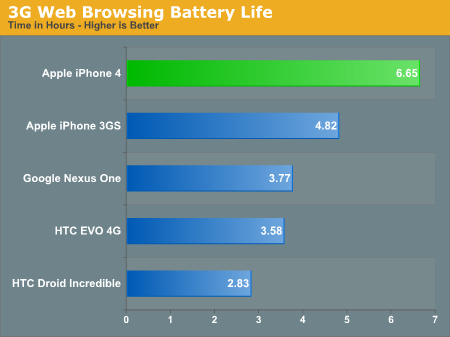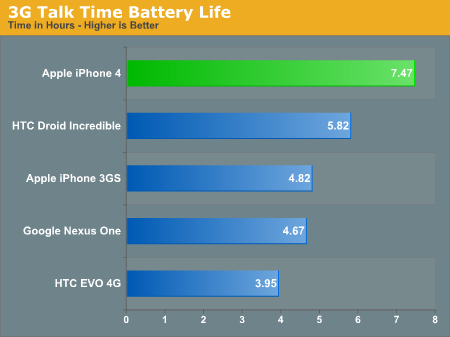Apple's iPhone 4: Thoroughly Reviewed
by Brian Klug & Anand Lal Shimpi on June 30, 2010 4:06 AM EST- Posted in
- Smartphones
- Apple
- iPhone 4
- Gadgets
- Mobile
Incredible Battery Life
I’ve publicly praised Apple for its honesty in reporting battery life over the past couple of years, and the iPhone 4 gives me no reason to stop.
The 4 has an integrated 5.25Whr battery. That’s around 95% of the battery capacity of the HTC EVO 4G, despite having much lower power frequirements. It’s also a 16% increase over the 4.51Whr battery that was in the iPhone 3GS. This means at bare minimum, assuming the iPhone 4 doesn’t draw any more power than the 3GS, we should get 16% more battery life.
In reality, we get much more.
When Apple introduced the iPhone 3G it dropped battery life to a level that we’d been stuck at ever since. The 3GS improved battery life a bit through better CPU power efficiency but you still didn’t have enough juice to get through a day without charging.
The iPhone 4 changes all of that. The combination of a larger battery and a more power efficient SoC results in an incredible amount of battery life.
Our first test is a basic web browsing benchmark. We've scripted almost two dozen webpages to load, pause for 20 seconds, then forward on to the next page. None of the pages use any Flash. This process repeats until the battery is dead. Screen brightness on the iPhones was set to 50% and the screens remained on the whole time.

Battery life improved nearly 38% with the iPhone 4. It's clear that while the A4 improved performance, the real improvement was in battery life. This test has enough idle time where good power management and low idle power can really impact the results. There's simply no other similar smartphone that can touch the 4's battery life.
We then repeated the same test over WiFi instead of 3G:

Apple claims the iPhone 4 will last for up to 10 hours over WiFi, we measured just under that at 9.96 hours. The improvement here is only 12.8%, which tells me that we're nearing the limit of how efficiently Apple can manage power in WiFi mode. There's a wall that we're quickly approaching with this current architecture.
To measure talk time we play MP3s on repeat into the mic of a phone and use it to call the phone being tested. The process continues until the test phone dies. In this case the screen is allowed to go to sleep, as it normally would be if you were talking on the phone:

Apple promised up to 7 hours of 3G talk time with the iPhone 4. We measured 7.47 hours. That's an increase of 54.9% over the iPhone 3GS. While in a phone call the majority of the A4 SoC is powered down, so the efficiency improvements here have to do with how much less power the A4 consumes while off and the new Skyworks 3G modem (the iPhone 3GS used an Infineon modem).
In our iOS 4 review we looked at the impact multitasking had on the iPhone 3GS' web browsing battery life. I ran our 3G web browsing test while playing music through Pandora in the background. I repeated the test with the iPhone 4 for today's article:

We actually see our largest battery life improvement in this test. With a 57.7% increase in battery life over the 3GS, the iPhone 4 is not only more efficient at idle workloads but also when the SoC is constantly busy. The A4 SoC is rumored to be built on a 45nm process compared to the 65nm SoC used in the 3GS. With a moderate increase in clock speed we should be seeing a lot of the power savings that a full node shrink brings to the table.
The battery life offered by the iPhone 4 is spectacular. My iPhone 3GS could hardly get through a full day of work while traveling, I'd always need to hunt for an outlet before heading into my dinner meeting. I'm about to take my first trip with the iPhone 4 but I get the feeling that I might finally be able to make it through dinner.
Early reports of 20 and 30 hours of battery life are simply exaggerated. They're only possible if you let the phone idle in your pocket for the majority of that time. In other words, if you don't use the phone it lasts for a long time. While that's a testament to the platform's incredible idle power, the real world usage is good enough to stand on its own. It's better than any iPhone or Android phone I've tested thus far.










270 Comments
View All Comments
strikeback03 - Tuesday, July 6, 2010 - link
I would assume they were referring to the launch of Windows Phone 7, which may prove to be a viable smartphone competitor. But being still months away that is a long time for competitors to move ahead.Also, as far as hardware goes, there are phones built with modern hardware, such as the HTC HD2. The software is the real problem.
softdrinkviking - Sunday, July 4, 2010 - link
the biggest turn off for me is still the lack of micro SD support.i use my phone as my primary mp3 player, and i end up filling up 16GB really quickly.
with SD cards, you can swap out your storage on the go, rather than having to return home and do a sync in itunes.
also, itunes is awful. it's such a pain in the ass to use, and i can think of no good reason that we can't drag and drop mp3 files onto our phones, or better yet, onto SD cards. (other than the fact that apple wants to force you to go through their online marketplace on a regular basis)
D3lta - Sunday, July 4, 2010 - link
By far the best review I've ever read. Thanks and keep up the good work.avoidz - Sunday, July 4, 2010 - link
Cynical maybe, but I'm sure this was all part of the plan, knowing that users would require the $30 bumper case.Consolidated - Sunday, July 4, 2010 - link
A rough (eyeball) estimate of your diagram finds the umts antenna to be about twice as long as the WiFi antenna. Connecting the two would increase the length of the umts antenna about 50%, midway between the base length and the first harmonic length. Nasty VSWR there.The same calculus INCREASES the wifi antenna length by a factor of three, just about the second harmonic (an odd harmonic, yes but way better than midway between, no?).
zero01 - Sunday, July 4, 2010 - link
This is a must have, I hear it fixes everythingVery funny although I cant see them selling many.
docflash - Sunday, July 4, 2010 - link
as a physician, i've had lots of patients who've had allergies to metal - nickel in particular. an effective fix is coating the metal, often in a ring or other piece of jewelry, with a couple of layers of clear nail polish. this doesn't allow their skin to touch the metal, and stops the allergy.it's *possible* that some clear nail polish would have the same effect on the metal of the iP4's antenna. now, i am not an engineer (nor do i play one on TV) but i see no reason this won't work. and if it does: well, i'm in the market for a new phone, and the iP4 could be it.
if it *does* work for you, great! but share the news - i'd like to try it myself (and so might other folks).
scubasteve03 - Monday, July 5, 2010 - link
I have searched everywhere! Where can I find that the background on the home screen in the " The Real Story on iPhone 4's Antenna" section? It has the vertical stripes that is yellow and black. If anyone could please help me figure out where to get send me an email. First person to find it for me gets 10 internet points! selphs03@gmail Thanks everyone!Romion - Monday, July 5, 2010 - link
First of all, regarding battery life I dont think that the real talk time is bigger than what Apple announced (about 7h). I know from experience that all my phones till now had talk times around 1/2 up to 2/3 of what manufacturer announced (the talk time announced is IDEAL, most probably non existent in real life.) Just curios, how did u check the talk time?BUT, MAYBE THIS IS A MAGICAL DEVICE AND I AM ALL WRONG.
Anand, if u use some technical data this doesnt mean that they are correct/ true and we can rely on this review.
U said that u were in line at mall for every Iphone model till now, well, that tell us/me everything.
Sorry if my english is not perfect, im not a native english speaker, but a smart enough guy to see things how they are in reality and not listen to others in their bias reviews.
gl
Stoli89 - Monday, July 5, 2010 - link
It would be interesting to understand if changes to the WiFi/Bluetooth/GPS portion of the antenna system has an impact on the 2G/3G portion. If energy from wifi and/or bluetooth and/or GPS is causing interference with the 2G/3G signal processing when the so-called "gap" is conductively bridged. Current test seem to focus on the 2G/3G antenna being de-tuned when the external antenna gap is bridged, without considering if energy is also leaking through and corrupting the 2G or 3G signal(s). Just curious if this is just one more parameter which has confused the outcomes for different customers.